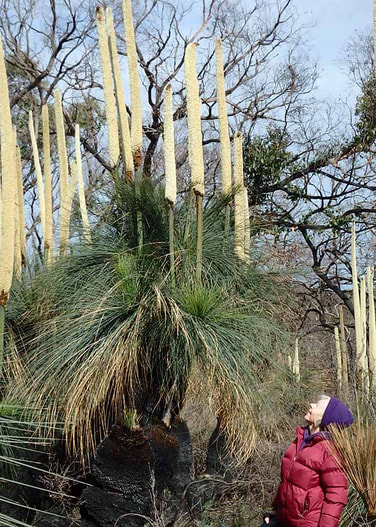 In February Grantville’s grass trees were ablaze. Today they’re
In February Grantville’s grass trees were ablaze. Today they’re putting on a spectacular show. Photos: Hartley Tobin
Along a fence between the Grantville Nature Conservation Reserve and the adjoining sand mine, scores of tall white vertical posts have appeared. For a moment visitors might be unsure what they are looking at. Surely it can’t be some enormous building going up with the white posts being uprights to support the roof?
A closer look shows the white uprights are growing out of grass tree bases, some with new green “skirts”.
Like children stepping into an alien land at the top of Enid Blyton’s Magic Faraway Tree, visitors stare at the spectacle of a forest of grass tree spear-like spikes up to 4.5 metres tall, some as thick as an arm and covered in tiny white to yellow blooms.
As their recently-blackened trunks show, Grantville’s grass trees were severely burned. Grass trees are slow growers with some of the taller species growing only 0.8cm to 6cm a year. Some species grow to six metres, not counting the spike and some live to 600 years. As some grass trees in the Grantville reserve are tall, they would have been there long before European occupation. An ancient tree, it has been called “a living fossil”, and it thrives in a sandy well-drained habitat. It also provides many species of mammals, birds and insects with a food source.
Indigenous Australians valued grass trees as a varied food source. They ate the white, tender sections of leaf bases, the growing points of stems and the roots, and they ground the seeds into a flour to make a type of damper which they cooked in hot ashes. They dug for grubs at the base of the trunk and extracted honey from carpenter bee nests bored into the pith of old dry flower stalks. They also used the plant’s leaf resin as an adhesive, for instance as a glue in spear-making and for waterproofing bark canoes and water containers, and as an item to trade. They used flower spikes for fishing spear shafts and firesticks, tough seed pods for cutting tools and nectar to make a sweet, slightly fermented drink.
Though fire might burn their leaves and trunks, grass trees can survive as their living growth-point is underground under tightly-packed leaf bases. The spring following a summer bushfire, large numbers of plants might send up flower spikes en masse, as they did in Grantville.
Currently, not only grass trees but an abundance of wildflowers greet visitors to the reserve: yellow hibbertias (guinea flowers), orchids, including lots of pink and purple fairy orchids, pink finger orchids, donkey orchids and flying duck orchids. Tree seedlings are also prolific and include wattles, eucalypts, melaleucas and sheoaks.
Visitors can park in the short road to the sandpit immediately south of the Grantville Tip. Weekends are best to avoid sand trucks. Park on the side of the road in front of the gate to the sandpit and walk south along the fenceline. As the terrain rises, the bigger grass trees start to become prolific, and eventually become a forest.
Sadly the bulk of the grass tree forest is not protected as it is on the land leased for sandmining. It is time authorities rectified this so even more of this iconic plant, found only in Australia, has a better chance of survival.
In the meantime visitors should take advantage of the chance to visit a natural botanical phenomenon not much more than an hour’s drive from Melbourne. Even travellers who cannot stop to walk up to the big grass tree forest can see many hundreds of white spikes on low grass trees scores deep lining the fence of the reserve along the Bass Highway. A sight to see!